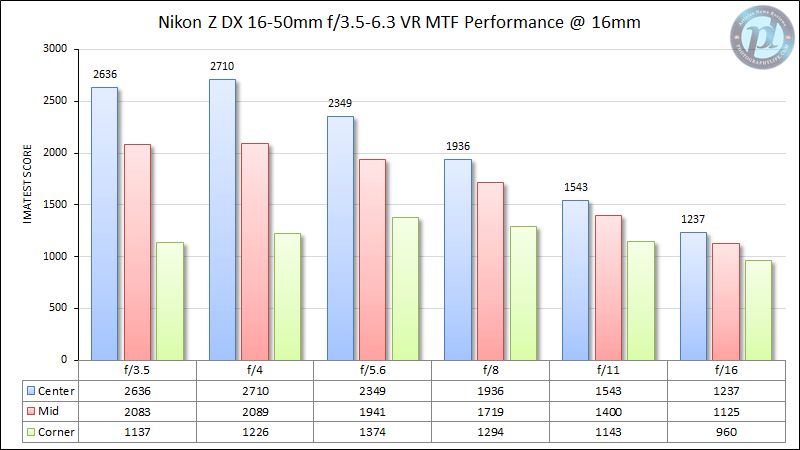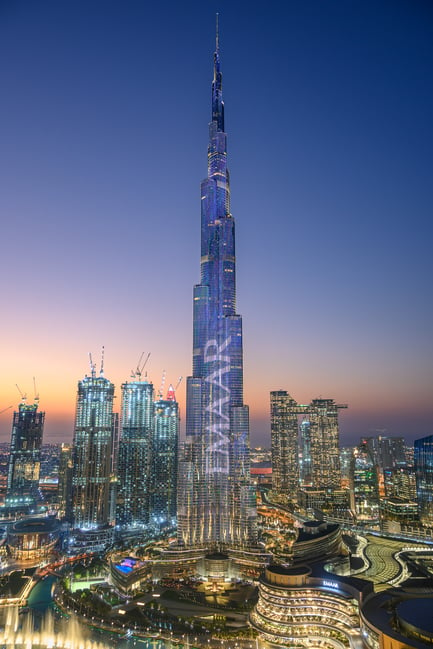Lens Sharpness, Contrast and Color
When I first got the Z DX 16-50mm VR together with the Nikon Z50 kit in my hands, I immediately thought of the previous 18-55m DX lenses I have used in the past, as well as other collapsible lenses from other systems. Simply put, my expectations were quite low. However, after taking the combo for a spin and taking a few pictures, I was pleasantly surprised by the sharpness, contrast, and color I was seeing straight out of the camera. Not something I expected at all from such a lens.

After I had a chance to post-process all the images from my trip to Jordan and Turkey, I was even more surprised to see the results. So I was anxious to see how the lens would do in a lab environment at different focal lengths. Below are the measurements performed by Imatest, from 16mm to 50mm:

As you can see, the lens starts out quite strong at 16mm. Center and mid-frame sharpness at f/3.5 and f/4 is excellent, but the corners are somewhat weak due to field curvature. However, once stopped down to f/5.6, the corners get noticeably better.

Zoomed in to 24mm, the lens gets strong both in the center, as well as the extreme corners. Stopping down to f/5.6 yields the best overall results.

Sharpness performance remains very good at 35mm, with f/5.6 once again yielding the best results from center to extreme corners.

As expected, sharpness goes down at the long end, and we can clearly see a drop in center resolution at maximum aperture. However, the extreme corners actually get sharper. When shooting at 50mm, you are better off using the maximum aperture, unless you need more depth of field.
Note that the lens performs quite evenly at f/8 across all focal lengths. So if you want to be safe, just stop it down to f/8 and be there.
For comparison, here is the Nikon-provided MTF chart for the lens:
Another good news is that the lens does not seem to suffer from any visible focus shift.

When it comes to contrast and color performance, while it is certainly not at the level of pro-level Nikon lenses, it is quite good for a kit lens. Colors look quite natural and pleasing to my eyes.
Focus Breathing
Surprisingly, the Nikon Z DX 16-50mm VR also shows very little focus breathing issues to worry about. This essentially makes the lens quite versatile for both stills (focus stacking), as well as video shooting needs.

Vibration Reduction Performance
As I have already pointed out earlier, the Nikon Z DX 16-50mm VR comes with optical image stabilization that Nikon calls “Vibration Reduction”. Per Nikon, the VR mechanism is supposed to provide up to 4.5 stops of compensation when shooting hand-held, which is basically on par with other modern Nikon lenses with VR.
When shooting with the Nikon Z50, I rarely relied on the tripod, because I wanted to test how good VR on this lens really is. Most of the images in this review (aside from ones shoot at very long exposures of 1 sec and longer) were captured hand-held. Here is an image I captured at 1/3 of a second at 50mm (75mm full-frame equivalent):

This works out to a bit over four stops of compensation with the reciprocal rule, which is pretty impressive. I had to bump up ISO to 400 in the above case since there was very little ambient light to work with.
Vignetting
Another issue I expected to see from the collapsible design of the Nikon Z DX 16-50mm VR was severe vignetting – I expected to see over two stops of it, especially at wide focal lengths. Although the lens certainly has quite a bit of vignetting, it is actually lower than I expected. Take a look at the below chart:

As you can see, the lens has almost two stops of vignetting at f/3.5 @ 16mm, which is about the same for both close and infinity focus. However, if you zoom in towards 50mm or stop down a little, vignetting is reduced significantly. The good news is, at its sweet spot of f/5.6-6.3 you don’t really need to worry about significantly darker corners. And if that bothers you, it is easy to take care of it in post-processing.
If you are a Lightroom user, vignetting correction applies automatically upon import, so you don’t have to worry about it.
Here is the worst-case scenario of vignetting at f/3.5, infinity focus, as illustrated by Imatest:

As you can see, only the very edges get a bit darker.

Using filters with the lens is not a problem – you will not see any darkening issues as a result of filter use. As I have already pointed out earlier, I used a pretty old and thick B+W polarizer on the 16-50mm. I did not see any problems with vignetting, even at 16mm.
Distortion
As expected from a kit zoom lens, Distortion is certainly there at all focal lengths. Imatest measured 4.27% barrel distortion at 16mm, which switches to pincushion distortion at 24mm and stays that way:

However, keep in mind that this is based on an uncorrected RAW file. By default, distortion correction is automatically turned on when mounting this lens on a Nikon Z camera, and you cannot turn it off. So you will never see the barrel or pincushion distortions when composing images in the field. When importing images into software like Lightroom, distortion correction applies automatically to all RAW images, so you will never see any distortion issues in your images when post-processing either.

Chromatic Aberration
Lateral chromatic aberration is not bad either for a kit lens, as can be seen from the chart below:

Imatest measured a bit over a pixel of lateral CA at 16mm. The worst part of the lens was from 24mm to 35mm, where we can see close to two pixels of chromatic aberration. However, at 50mm, it practically disappears.
Once again, lateral chromatic aberration is not something you will need to worry about when using Lightroom, since lens correction will automatically be enabled.
Bokeh
If you get close enough to your subject while zoomed in to 50mm, you can get pretty decent out of focus blur. Out-of-focus highlights look somewhat round and smooth, although you can’t really expect much from an f/6.3 setup. If you want better bokeh, I would recommend getting the Nikon Z 50mm f/1.8 S prime, which is a far better choice in this aspect.

Ghosting and Flare
Nikon did a great job with the coatings on the Z DX 16-50mm VR, since both ghosting and flare are controlled quite well. Take a look at the below image:

As you can see, although the sun is in the frame (which I partially blocked with the hill on the left for sun stars), there are no signs of ghosting and flare in this image, aside from a little bit of green color cast near the highlight. Obviously, the angle of light and the position of the sun in the frame can certainly impact the way lenses handle ghosting and flare, but in the case of the Nikon Z DX 16-35mm VR, it is not a problem in most situations.
Starburst Performance
As evidenced from the above image, the Nikon Z DX 16-35mm VR can produce somewhat pleasing sun star images, but if you are after pretty sun stars, this is definitely not the lens for it. With its 7-blade rounded diaphragm, you will see 14-point starbursts that divide up into smaller lines and quickly dissipate.

Coma
There is definitely some visible coma when shooting at 16mm, with points of light taking a triangular shape in the extreme edges of the frame. To be honest, it is not something I would even worry about, since it is not a lens you would be using to shoot the Milky Way anyway.
Table of Contents
